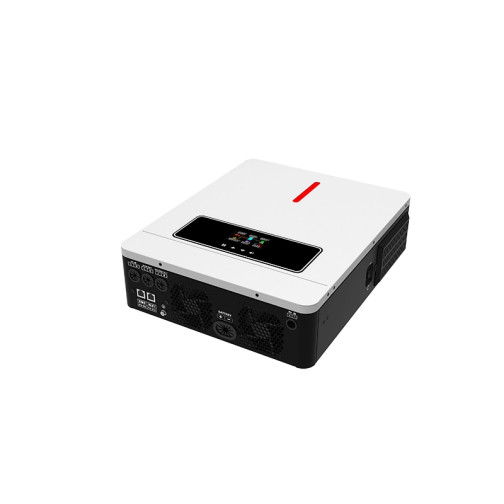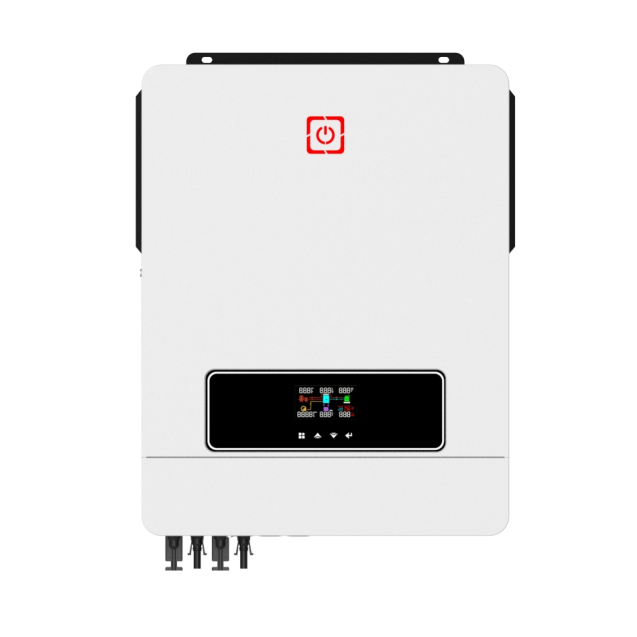- All
- Product Name
- Product Keyword
- Product Model
- Product Summary
- Product Description
- Multi Field Search
Views: 11 Author: Site Editor Publish Time: 2025-10-20 Origin: Site








In the field of new energy power generation and electrical conversion, pure sine wave hybrid inverters have become core equipment for diverse power applications due to their exceptional power quality and broad compatibility. Whether in residential solar power systems, industrial production equipment, or medical emergency devices, their stable support is indispensable. As renewable energy becomes more widespread, the importance of pure sine wave inverters continues to grow.
This article provides a comprehensive analysis covering definitions, operating mechanisms, advantages and disadvantages, differences from modified sine wave inverters, and applicable scenarios to help you precisely select solar inverter tailored to your specific needs.


A pure sine wave hybrid inverter is an electronic device that converts direct current (DC) into alternating current (AC). Its characteristic is the output of a smooth, continuous sine wave—an AC waveform nearly identical to that supplied by the utility grid.
The sine wave represents the ideal AC waveform, where voltage and current vary periodically over time, perfectly matching the design requirements of most electrical equipment. Compared to other inverter types, pure sine wave inverters deliver purer electrical energy without generating additional harmonic interference. This purity is crucial for their compatibility with sensitive devices.
The input DC power undergoes preliminary processing. If the input source is DC power (e.g., solar panels or batteries), the device first employs a filter circuit to eliminate noise and fluctuations in the current, ensuring stable and pure DC power for subsequent stages. If the input is AC power (e.g., from a generator), it must first pass through a rectifier circuit to convert AC to DC before undergoing filtering, laying the groundwork for the subsequent inverter process.
The pretreated DC power is fed into the inverter bridge circuit, composed of high-power semiconductor devices like MOSFETs (Metal-Oxide-Semiconductor Field-Effect Transistors) or IGBTs (Insulated-Gate Bipolar Transistors). Driven by the control circuit, these semiconductor devices rapidly switch on and off at extremely high frequencies, chopping the DC power into a series of pulse signals. The resulting pulse signals remain irregular "rough waveforms," significantly differing from standard sine waves.
To transform the rough pulse waveform into a smooth sine wave, it undergoes processing through a filter circuit (typically composed of inductors and capacitors). The filter circuit removes higher harmonics from the pulse signal, gradually shaping the waveform toward a sine wave. Simultaneously, the built-in voltage and frequency regulation modules continuously monitor the output AC parameters. Should voltage fluctuations or frequency deviations occur, immediate adjustments are made to ensure the final output AC voltage and frequency remain within stable ranges, meeting the requirements of connected electrical devices.
Additionally, modern pure sine wave solar inverters also integrate intelligent MPPT (Maximum Power Point Tracking) technology. This enables real-time tracking of the maximum power output point of solar panels, maximizing the capture of solar energy and enhancing the overall energy efficiency of the power generation system.
Exceptional Compatibility: With output waveforms identical to utility power, pure sine wave solar inverters support virtually all electrical equipment—from precision electronics (computers, medical devices) to inductive loads (air conditioners, refrigerators, motors)—without startup failures or operational anomalies.
Effective Equipment Protection: Pure sine wave power minimizes harmonic damage to electrical devices, preventing issues like overheating, excessive noise, and performance degradation caused by current interference. This significantly extends equipment lifespan and reduces maintenance/replacement costs.
High Operational Stability: With precise voltage and frequency regulation, output parameters remain stable even under fluctuating loads, ensuring continuous, reliable operation—ideal for scenarios demanding high power stability.
Smart MPPT: Integrated intelligent MPPT functionality optimizes solar energy harvesting efficiency, enabling solar panels to deliver maximum power output under varying light conditions and boosting overall renewable energy system generation.
Remote Monitoring Support: Premium models feature remote monitoring capabilities, allowing users to view inverter operational status, power generation, and fault information in real-time via mobile apps or computer clients for convenient remote management and timely maintenance.
Dustproof and Durable: Industrial-grade pure sine wave inverters typically feature sealed enclosures with excellent dustproof, moisture-resistant, and shock-resistant properties. They withstand harsh outdoor or factory workshop environments, ensuring extended service life.
Higher Initial Cost: Compared to modified sine wave inverters, pure sine wave inverters feature more complex circuitry requiring higher-quality semiconductor components and filter assemblies. This results in increased manufacturing costs and relatively higher retail prices.
Larger Size and Weight: To achieve precise waveform conversion and stable output, pure sine wave inverters require additional circuit modules and cooling systems. This results in larger dimensions and heavier weight compared to modified sine wave inverters, needing specific installation space requirements.
Higher Maintenance Costs: Due to their complex internal structures, repairs often require specialized technicians and dedicated replacement parts. This leads to longer repair cycles and relatively higher maintenance expenses.
Feature | Pure Sine Wave Inverter | Modified Sine Wave Inverter |
Waveform | Smooth, continuous | Stepped or square |
Compatibility | All electrical equipment | Basic resistive loads |
Efficiency | 92–98% | 75–85% |
EMI Performance | Minimal interference | Higher interference |
Cost | Higher | Lower |
Application | Industrial, medical, solar systems | Small appliances, basic tools |
Pure Sine Wave Inverter: Outputs a smooth, continuous sine wave nearly identical to utility grid supply.
Modified Sine Wave Inverter: Outputs a stepped or square wave—a coarse approximation of a sine wave.
Pure Sine Wave Inverter: Delivers exceptionally high power quality with minimal harmonic content, causing no interference to electrical equipment. Compatible with all electrical devices, particularly suited for precision instruments and inductive loads. However, it suffers from high cost and bulky size.
Modified Sine Wave Inverter: Features a simple structure, low manufacturing costs, and affordable pricing; exhibits high efficiency when driving resistive loads. However, it generates significant harmonic content and inferior power quality, potentially causing severe motor overheating, noise generation, and even malfunctioning of certain precision electronic equipment.
Pure Sine Wave Inverters: Widely used in scenarios demanding high power quality, including household appliances (air conditioners, refrigerators, audio systems), medical equipment (MRI machines, ventilators), industrial equipment (motors, automated production lines), and solar power systems (grid-connected or off-grid).
Modified Sine Wave Inverters: Primarily used in simple applications with lower power quality demands, such as basic small appliances (electric fans, kettles), lighting equipment, mobile phone chargers, and small power tools.
EMI (Electromagnetic Interference) Performance: Pure sine wave inverters exhibit extremely low electromagnetic interference, easily meeting international certification standards like CE and FCC without requiring additional filtering components. Modified sine wave inverters generate stronger electromagnetic interference and require additional filtering components to meet relevant certification requirements.
Peak Conversion Efficiency: Pure sine wave inverters achieve higher peak conversion efficiency, typically ranging from 92% to 98%, resulting in minimal energy loss. Modified sine wave inverters exhibit lower peak conversion efficiency, generally between 75% and 85%, leading to relatively higher energy waste.
Convert DC from solar panels into grid-compatible AC, maximizing power use and efficiency.
Provide stable power for sensitive devices like ventilators, MRI machines, and monitors.
Support continuous operation of production lines, motors, and HVAC systems with high load stability.

Supports both grid-tied and off-grid operation modes, allowing flexible switching based on actual power requirements.
Features high-efficiency MPPT controller that precisely tracks the maximum power point of solar panels, significantly enhancing solar energy utilization.
Features an industrial-grade dustproof enclosure designed for harsh outdoor environments, ensuring a service life exceeding 10 years.
Supports remote monitoring via mobile app, enabling real-time tracking of power generation, load status, and fault alerts for convenient daily management and maintenance.
Achieves peak conversion efficiency of 97%, minimizing energy loss and delivering substantial electricity cost savings.


Specifically designed for industrial production, large commercial buildings, and large-scale residential users to meet high-load power demands.
Offers robust compatibility to drive various industrial machinery, central air conditioning systems, large refrigeration equipment, and more.
Employs advanced circuit protection technology with multiple safeguards against overvoltage, overcurrent, overload, and short circuits, ensuring safety for both the inverter and connected equipment.
Peak conversion efficiency reaches 98%, leading the industry and minimizing energy waste.
Supports remote monitoring and intelligent operation and maintenance, enabling users to promptly identify and resolve equipment issues to ensure stable system operation.
Pure sine wave inverters are indispensable in the transition to clean energy. They ensure stable, efficient, and safe power conversion for a wide range of applications—from homes to industries.
With over 20 years of inverter manufacturing expertise, Thlinkpower delivers reliable hybrid and pure sine wave solar inverters engineered for performance, durability, and intelligent control.
Learn more at www.thlinkpower-energy.com